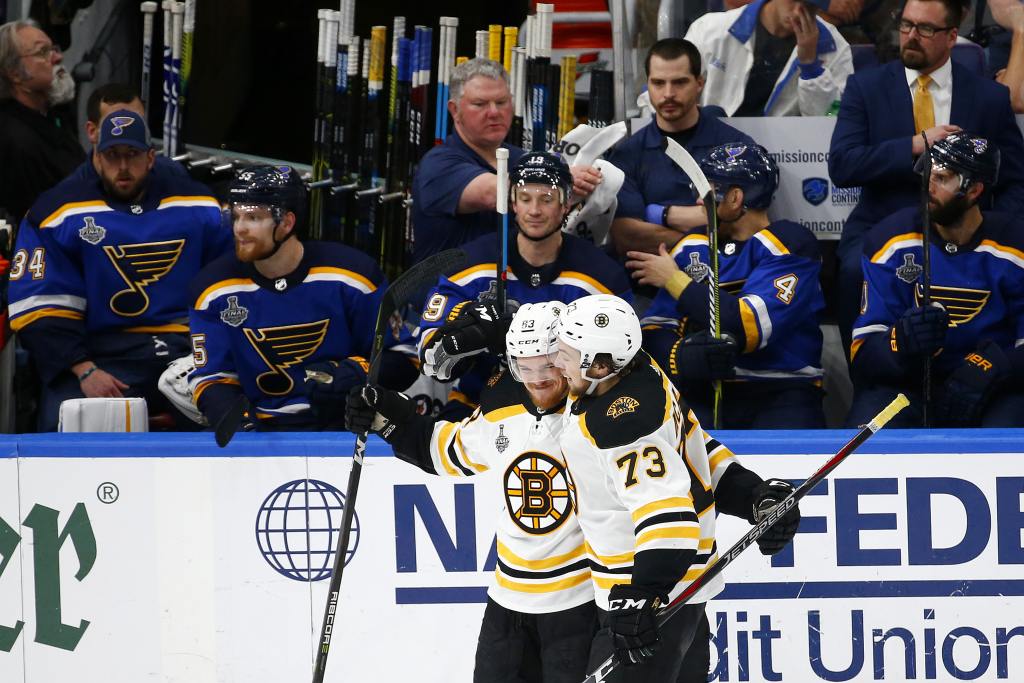Karson Kuhlman was exactly what struggling second line needed

ST LOUIS, MISSOURI – JUNE 09: Karson Kuhlman #83 of the Boston Bruins is congratulated by his teammate Charlie McAvoy #73 after scoring a third period goal against the St. Louis Blues in Game Six of the 2019 NHL Stanley Cup Final at Enterprise Center on June 09, 2019 in St Louis, Missouri. (Photo by Dilip Vishwanat/Getty Images)
By Ty Anderson, 985TheSportsHub.com
You don’t get to this point of the NHL season without pressing the right buttons more than a few times along the way.
But Bruins coach Bruce Cassidy’s latest move, which saw Karson Kuhlman rejoin the B’s lineup for his first playoff game since Apr. 30, may very well go down as the one that legitimately saved the Black and Gold’s season.
Thrown back into action on a second line with Jake DeBrusk and David Krejci, the 23-year-old Kuhlman made an immediate impact, with the goal that put the Blues away by way of a 3-0 score with 9:45 remaining in the third period, on the way to a 5-1 final at the Enterprise Center on Sunday night.
https://twitter.com/mkmolnar/status/1137926838125301760
Nights don’t get much better than that, really, as Kuhlman finished with a one-shot, one-goal night in 13:07 of action.
But the Minnesota-born winger’s contributions went beyond just the strike.
Riding to the right of the struggling DeBrusk-Krejci combination, Kuhlman’s jump was certainly noticeable from his first shift, as the line seemed to finally have speed, as well as space.
With Kuhlman’s quick wheels out there instead of the steamboat-styled David Backes, the Blues had to pay actual attention to the threat on the right side of the rink from something beyond a physicality standpoint, and Kuhlman’s ability to keep up with DeBrusk and vice versa truly brought the best out of both wingers. You saw this play out to some stronger d-zone coverage (the Bruins played deep in their own zone throughout the winning effort), as well as quick turnarounds the other way for offensive looks. (This was not the case through the first four games of this series, of course, with DeBrusk constantly looking like he was a solid 20 feet ahead of the play.)
Smarter and quicker along the walls, Kuhlman’s work also appeared to extend plays and create space for Krejci throughout the night, with No. 46 possessing the puck at the same rate he did in Game 5 with a two-man, high-skilled rotation to his right. That board-work also helped the Bruins score what was the game-winning knuckleball of a goal from Brandon Carlo, as Kuhlman provided support to what was a dogged fight along the boards for DeBrusk, giving No. 74 the help necessary to shift the puck up towards Carlo for the wobbling shot that broke Jordan Binnington’s brain into a million pieces.
An unforgivably bad goal to give up, you also had to like Kuhlman’s drive towards the middle on the shot, which tied up Blues defenseman Vince Dunn and provided another two bodies Binnington had to (unsuccessfully) look through on the play.
And Kuhlman consistently did things that you simply couldn’t see Backes doing — or had not accomplished — while skating with DeBrusk and Krejci. Hell, you could argue that Kuhlman even outshined David Pastrnak and Marcus Johansson in their brief Game 5 runs with the Krejci-DeBrusk tandem.
These are simple plays, obviously, but in a series of overthinking everything, Kuhlman’s approach was everything the Bruins needed.
Lost in all of this, of course, is the fact that Kuhlman wasn’t considered your No. 1 go-to when in need of a jolt of life.
Especially in a do-or-die Game 6 for the Stanley Cup.
With 17 total games of NHL experience between the regular season and postseason to his name, turning to Kuhlman to save the season seemed like Cassidy overthinking his team’s situation. (I said as much when pinch-hitting for Chris Gasper on last Saturday’s Gasper and Murray on 98.5 The Sports Hub, so technically this cold take should be credited to Gasper, and on this topic, I refuse to bend.)
Cassidy had Backes, recharged and borderline angry after sitting out Game 5 as a healthy scratch in the press box waiting for another chance, and the postseason sample to that point had indicated that a more effective, nastier Backes would have rejoined the Boston lineup for Game 6. The optics of Backes, who spent the first 10 years of his career as a Blue, sitting the crucial games of this series out as a healthy scratch, are undeniably uncomfortable. It’d be easy for a coach to say that he was going to ride and/or die with his veteran. But Cassidy instead opted for the 2018 NCAA champion.
You had a seven defenseman approach, which would have covered the B’s rears in a series headlined by the in-game losses of defenders. And given the way the Bruins rotated their wingers as a whole in search of more offense in Game 5, something that worked with varying results depending on the trio formed, going with 11 forwards in a must-win almost made sense.
Instead, Cassidy gave a top-six role to a player whose only impact in the ’19 Cup Final up to that point had been as chief navigator of an overcrowded, media-filled locker room as a result of the extra work he put in well after practice.
And it paid off.
Ty Anderson is a writer and columnist for 985TheSportsHub.com. He has also been a voting member of the Boston Chapter of the Professional Hockey Writers’ Association since 2013. Any opinions expressed do not necessarily reflect those of 98.5 The Sports Hub, Beasley Media Group, or any subsidiaries. Yell at him on Twitter: @_TyAnderson.




